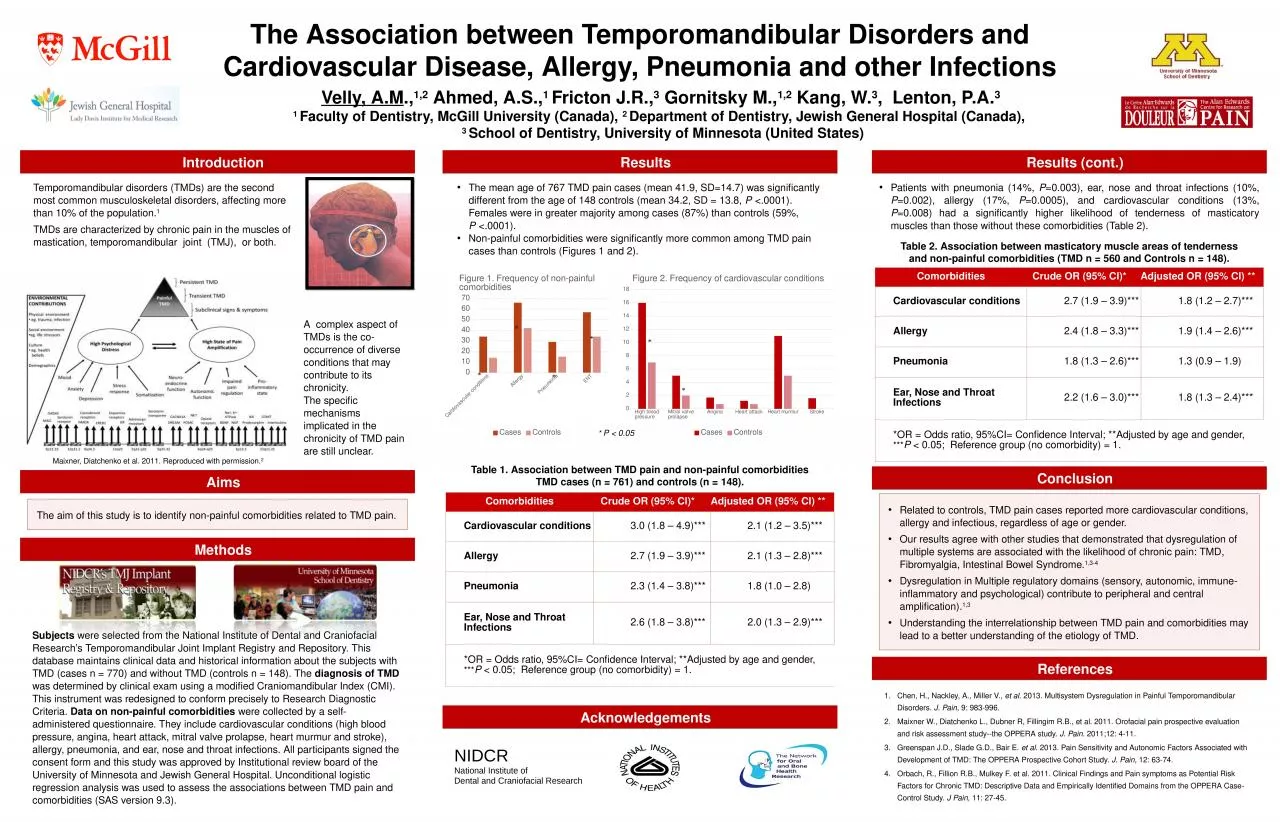

1 Fricton JR 3 Gornitsky M 12 Kang W 3 Lenton PA 3 1 Faculty of Dentistry McGill University Canada 2 Department of Dentistry Jewish General Hospital Canada ID: 934921
Download Presentation The PPT/PDF document "Velly, A.M ., 1,2 Ahmed, A.S.," is the property of its rightful owner. Permission is granted to download and print the materials on this web site for personal, non-commercial use only, and to display it on your personal computer provided you do not modify the materials and that you retain all copyright notices contained in the materials. By downloading content from our website, you accept the terms of this agreement.
Slide1
Velly, A.M.,1,2 Ahmed, A.S.,1 Fricton J.R.,3 Gornitsky M.,1,2 Kang, W.3, Lenton, P.A.3 1 Faculty of Dentistry, McGill University (Canada), 2 Department of Dentistry, Jewish General Hospital (Canada), 3 School of Dentistry, University of Minnesota (United States)
Subjects were selected from the National Institute of Dental and Craniofacial Research’s Temporomandibular Joint Implant Registry and Repository. This database maintains clinical data and historical information about the subjects with TMD (cases n = 770) and without TMD (controls n = 148). The diagnosis of TMD was determined by clinical exam using a modified Craniomandibular Index (CMI). This instrument was redesigned to conform precisely to Research Diagnostic Criteria. Data on non-painful comorbidities were collected by a self-administered questionnaire. They include cardiovascular conditions (high blood pressure, angina, heart attack, mitral valve prolapse, heart murmur and stroke), allergy, pneumonia, and ear, nose and throat infections. All participants signed the consent form and this study was approved by Institutional review board of the University of Minnesota and Jewish General Hospital. Unconditional logistic regression analysis was used to assess the associations between TMD pain and comorbidities (SAS version 9.3).
Chen, H., Nackley, A., Miller V., et al. 2013. Multisystem Dysregulation in Painful Temporomandibular Disorders. J. Pain, 9: 983-996.Maixner W., Diatchenko L., Dubner R, Fillingim R.B., et al. 2011. Orofacial pain prospective evaluation and risk assessment study--the OPPERA study. J. Pain. 2011;12: 4-11.Greenspan J.D., Slade G.D., Bair E. et al. 2013. Pain Sensitivity and Autonomic Factors Associated with Development of TMD: The OPPERA Prospective Cohort Study. J. Pain, 12: 63-74.Orbach, R., Fillion R.B., Mulkey F. et al. 2011. Clinical Findings and Pain symptoms as Potential Risk Factors for Chronic TMD: Descriptive Data and Empirically Identified Domains from the OPPERA Case-Control Study. J Pain, 11: 27-45.
The Association between Temporomandibular Disorders and Cardiovascular Disease, Allergy, Pneumonia and other Infections
The mean age of 767 TMD pain cases (mean 41.9, SD=14.7) was significantly different from the age of 148 controls (mean 34.2, SD = 13.8,
P
<.0001). Females were in greater majority among cases (87%) than controls (59%, P <.0001). Non-painful comorbidities were significantly more common among TMD pain cases than controls (Figures 1 and 2).
Patients with pneumonia (14%, P=0.003), ear, nose and throat infections (10%, P=0.002), allergy (17%, P=0.0005), and cardiovascular conditions (13%, P=0.008) had a significantly higher likelihood of tenderness of masticatory muscles than those without these comorbidities (Table 2).
Results
Temporomandibular disorders (
TMDs) are the second most common musculoskeletal disorders, affecting more than 10% of the population.1 TMDs are characterized by chronic pain in the muscles of mastication, temporomandibular joint (TMJ), or both.
NIDCR
National Institute of
Dental and Craniofacial Research
Related to controls, TMD pain cases reported more
cardiovascular conditions,
allergy and
infectious, regardless of age or gender.
Our results agree with other studies that demonstrated that dysregulation of multiple systems are associated with the likelihood of chronic pain: TMD, Fibromyalgia, Intestinal Bowel Syndrome.
1,3-4
Dysregulation in Multiple regulatory domains (sensory, autonomic, immune-inflammatory and psychological) contribute to peripheral and central
amplification).1,3 Understanding the interrelationship between TMD pain and comorbidities may lead to a better understanding of the etiology of TMD.
The aim of this study is to identify non-painful comorbidities related to TMD pain.
ComorbiditiesCrude OR (95% CI)*Adjusted OR (95% CI) **Cardiovascular conditions3.0 (1.8 – 4.9)***2.1 (1.2 – 3.5)***Allergy2.7 (1.9 – 3.9)***2.1 (1.3 – 2.8)***Pneumonia2.3 (1.4 – 3.8)***1.8 (1.0 – 2.8)Ear, Nose and Throat Infections2.6 (1.8 – 3.8)***2.0 (1.3 – 2.9)****OR = Odds ratio, 95%CI= Confidence Interval; **Adjusted by age and gender, ***P < 0.05; Reference group (no comorbidity) = 1.
Introduction
Aims
Methods
Acknowledgements
References
Conclusion
Results (cont.)
American Academy of Orofacial Pain
Table 2. Association between masticatory muscle areas of tenderness and non-painful comorbidities (TMD n = 560 and Controls n = 148).
ComorbiditiesCrude OR (95% CI)*Adjusted OR (95% CI) **Cardiovascular conditions2.7 (1.9 – 3.9)***1.8 (1.2 – 2.7)***Allergy2.4 (1.8 – 3.3)***1.9 (1.4 – 2.6)***Pneumonia1.8 (1.3 – 2.6)***1.3 (0.9 – 1.9)Ear, Nose and Throat Infections2.2 (1.6 – 3.0)***1.8 (1.3 – 2.4)****OR = Odds ratio, 95%CI= Confidence Interval; **Adjusted by age and gender, ***P < 0.05; Reference group (no comorbidity) = 1.
A complex aspect of TMDs is the co-occurrence of diverse conditions that may contribute to its
chronicity.The specific mechanisms implicated in the chronicity of TMD pain are still unclear.
Maixner
,
Diatchenko et al. 2011. Reproduced with permission.2
Table 1. Association between TMD pain and non-painful comorbiditiesTMD cases (n = 761) and controls (n = 148).
*
*
*
*
*
*
*
P
<
0.05